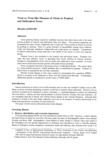Virus or Virus-like Diseases of Citrus in Tropical and Subtropical Zones
JIRCAS international symposium series
| ISSN | 13406108 |
|---|---|
| NII recode ID (NCID) | AA1100908X |

Full text
intlsymp-3_61-66.pdf265.31 KB
Citrus greening disease caused by fastidious bacteria that infect sieve cells is the most serious problem in tropical and subtropical Asia and Africa. The greening organisms are transmitted by insect vectors, Diaphorina citri in Asia and Trioza erytreae in Africa as well as by grafting or layering. There is a great diversity in susceptibility among citrus cultivars. 'Ladu' and 'Som-pan' mandarins, Calamondin and rough lemon are resistant. Transmission in fields is enhanced by strong wind due to the ability of the vector to move over long distances.
Tristeza virus is also prevalent in the tropical and subtropical zones. Toxoptera citricidus,the most effective vector, is spreading from South America to Central America. Changes in transmissibility of the virus by aphid were observed in many countries. In recent years severe strains have become popular and caused serious problems.
Citrus variegated chlorosis is becoming serious in subtropical Brazil. The causal agent is a xylem-limited bacterium, Xylella fastidiosa that is transmitted by grafting. Presence of insect-vector is assumed but has not been confirmed.
Witches' broom disease of lime trees caused by mycoplasma-like organisms (WBDL-MLO) is prevalent in the Sultanate of Oman and the United Arab Emirates. A leafhopper, Hishimonus phycitis is considered to be the vector of WBDL-MLO.
Tristeza virus is also prevalent in the tropical and subtropical zones. Toxoptera citricidus,the most effective vector, is spreading from South America to Central America. Changes in transmissibility of the virus by aphid were observed in many countries. In recent years severe strains have become popular and caused serious problems.
Citrus variegated chlorosis is becoming serious in subtropical Brazil. The causal agent is a xylem-limited bacterium, Xylella fastidiosa that is transmitted by grafting. Presence of insect-vector is assumed but has not been confirmed.
Witches' broom disease of lime trees caused by mycoplasma-like organisms (WBDL-MLO) is prevalent in the Sultanate of Oman and the United Arab Emirates. A leafhopper, Hishimonus phycitis is considered to be the vector of WBDL-MLO.
| Creator | Meisaku KOIZUMI |
|---|---|
| Publisher | Japan International Research Center for Agricultural Sciences |
| Available Online | |
| Issue | 3 |
| spage | 61 |
| epage | 66 |
| Language | eng |
